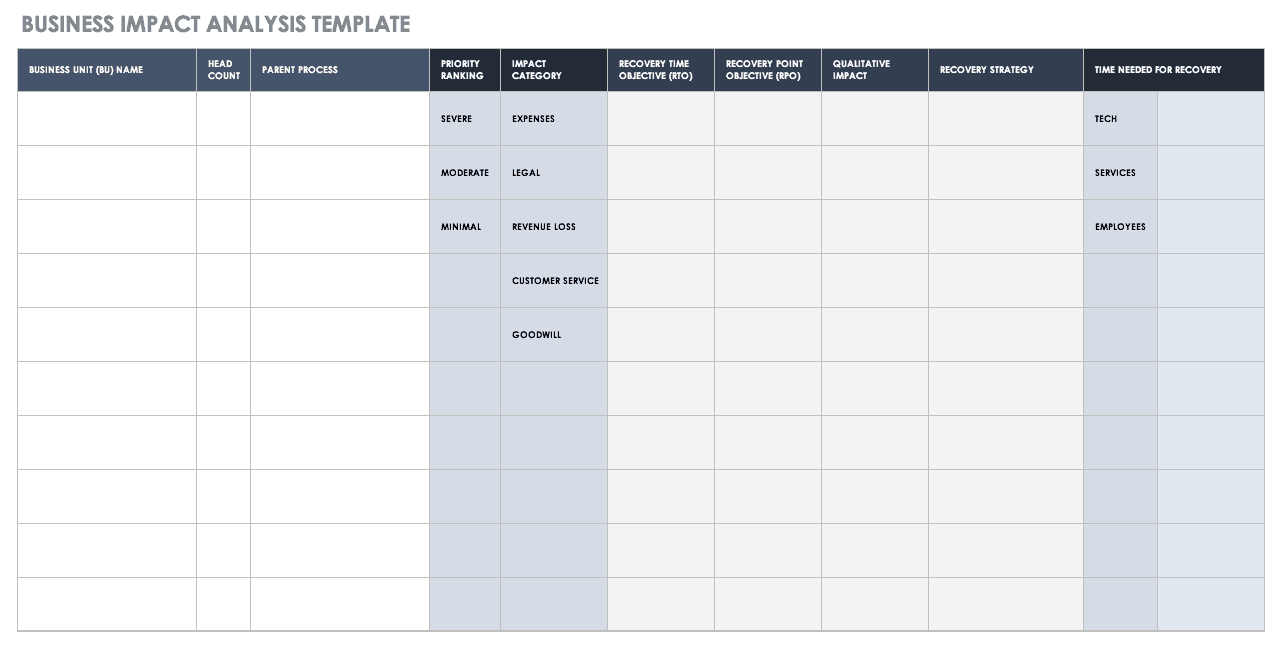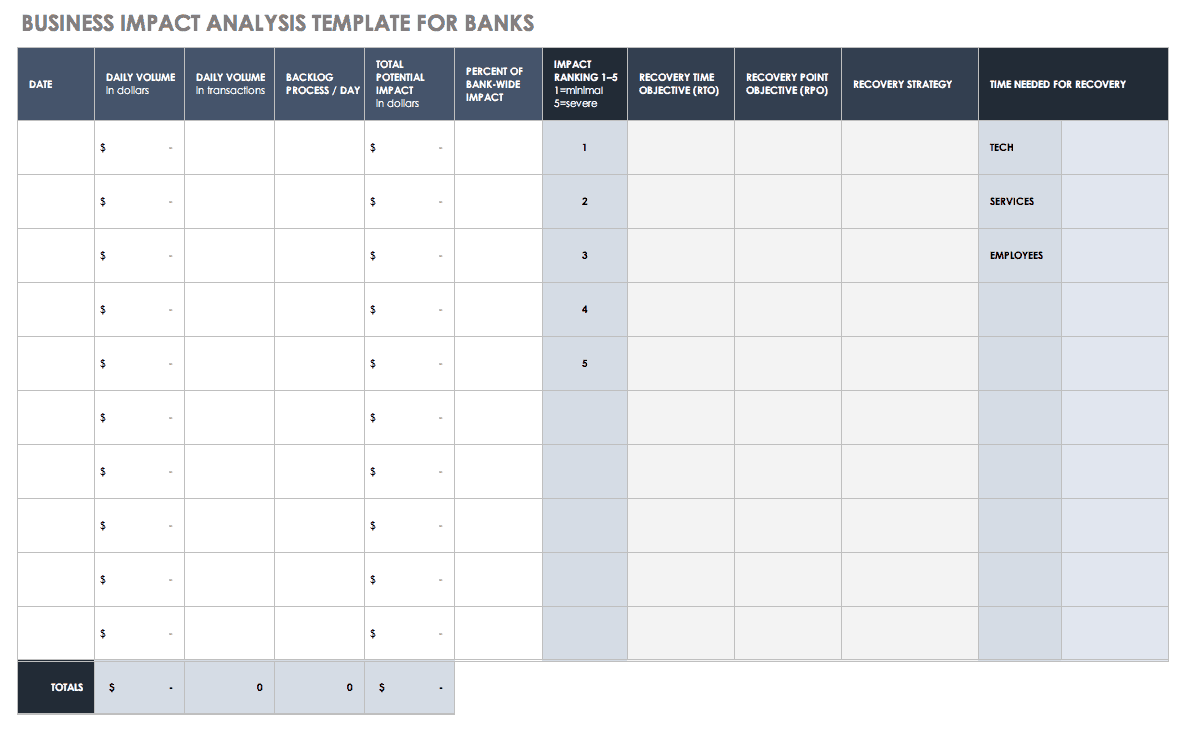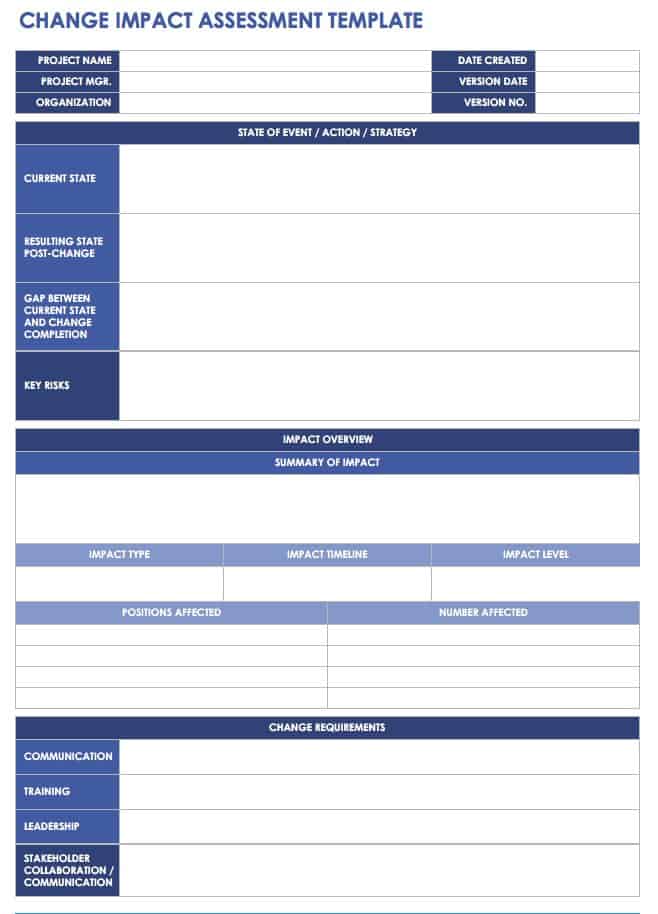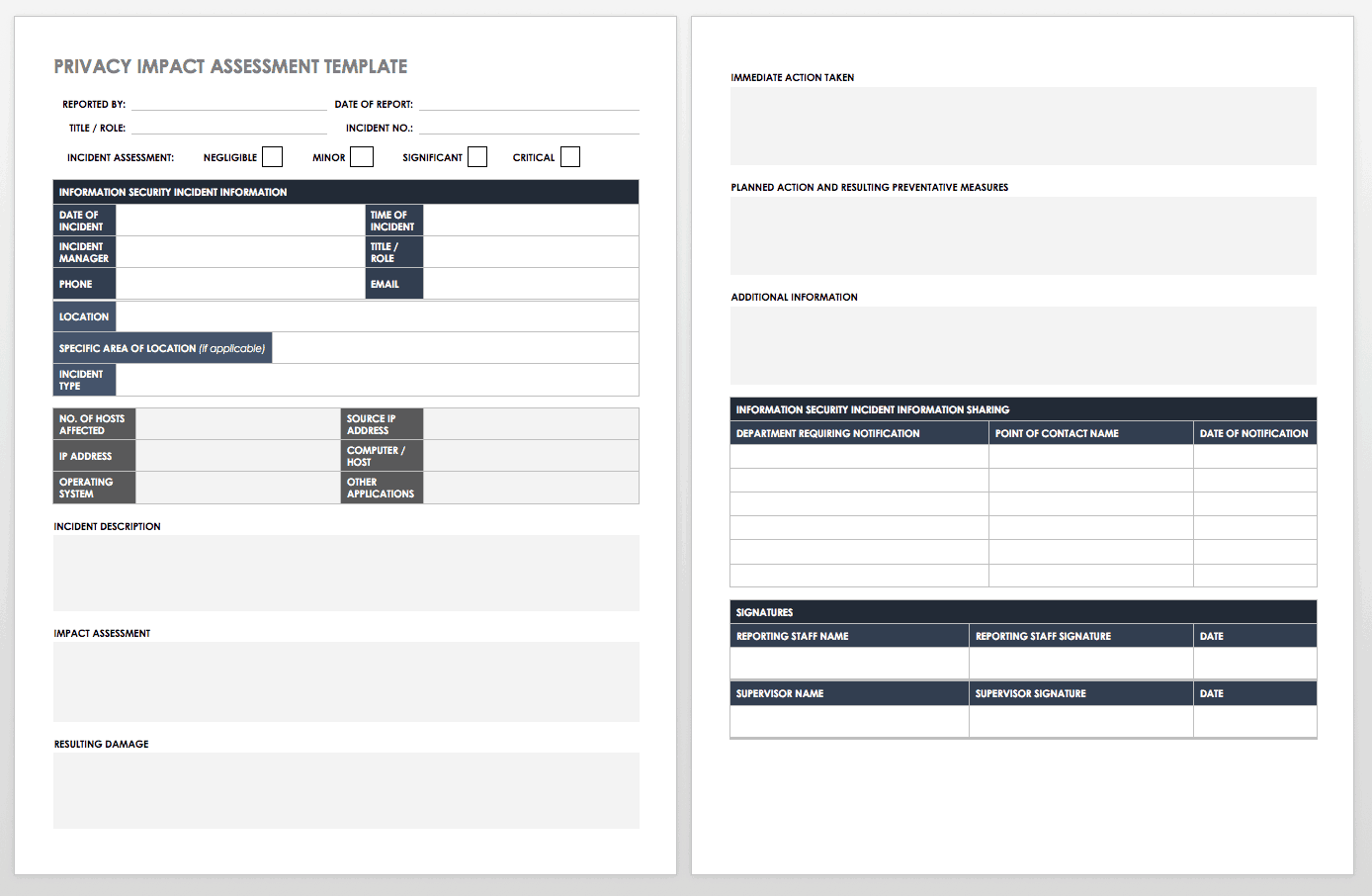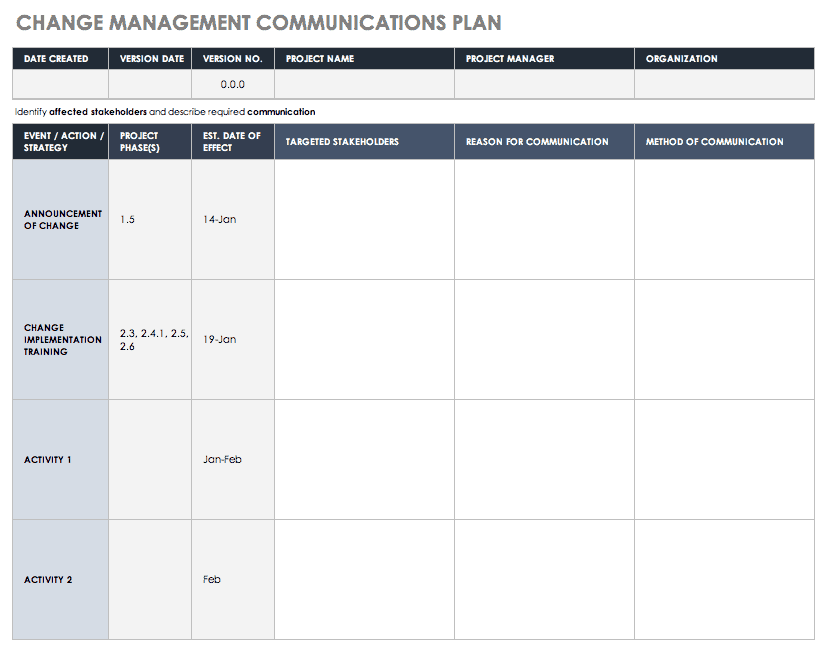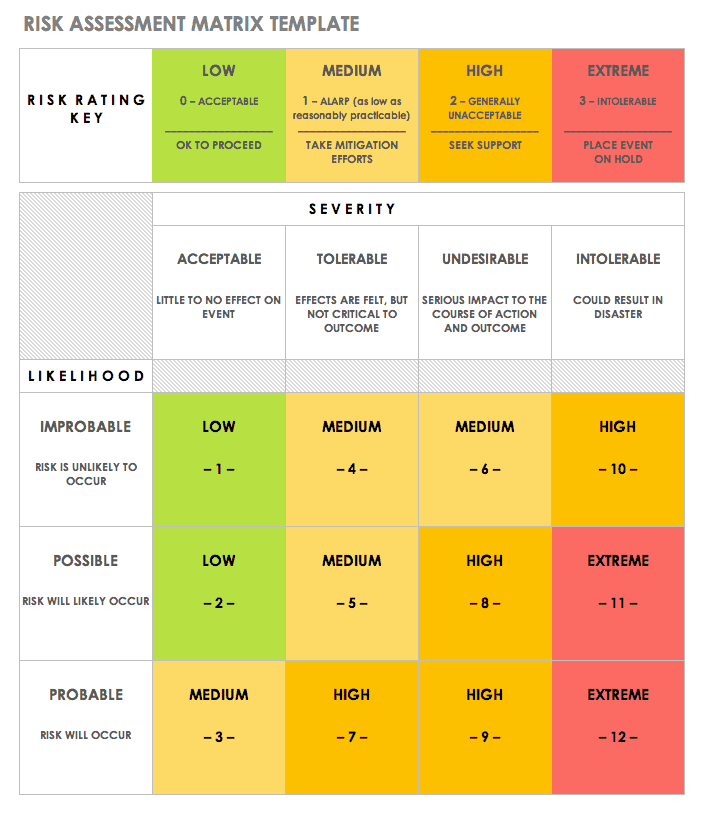Business Impact Analysis Template
This business impact analysis template is designed for companies to establish a clear plan of action after a disruption in normal business processes. Through both qualitative and quantitative business operation variables, a BIA collects information to develop a targeted recovery strategy to maintain productivity and business continuity. These variables include recovery time objective (RTO), recovery point objective (RPO), and maximum tolerable downtime (MTD). By identifying severity of impact, resource requirements, and recovery priorities, a company can minimize its recovery time. After these initial components are established, the BIA can assess the financial and operational impacts based on the levels of severity afflicted on business units, departments, and processes. You can also use this template to keep key stakeholders informed, along with all points of contact that the impact effects.
Download Business Impact Analysis Template
Excel | Word | PDF | Smartsheet
Business Impact Analysis Template for Banks
This form is geared towards companies in banking. The template reports on how critical business functions are specific to banks, like market shares, economy performance, stock value, and profit. This risk probability assessment gives a company a better sense of how they can bounce back after a worst-case disruption caused by uncontrolled events in the economy. This form calculates and summarizes cost through dollar and non-dollar impacts to create a crucial disaster policy for banking companies.
Download Business Impact Analysis Template for Banks - Excel
Change Impact Assessment Template
Changes that occur due to an impact can be examined using this change impact assessment template. An impact assessment characterizes the impact on business processes in the form of the people, systems, and procedures that will be affected as a result of the change. This basic guide will monetize the impact of loss by analyzing specific components like timing of impact, risk of change, and mitigation actions. Use this template in conjunction with larger management plans to supplement impact information about other specific business changes.
Download Change Impact Assessment Template
Excel | Word | PDF | Smartsheet
Privacy Impact Assessment Template
Along with naturally-occurring events, information security is an impact that could leave a business with stalled processes. This IT incident report template aids in identifying and securing all data breaches, privacy violations, viruses, and malware attacks. Use the form to collect information like compromised personal information, current security measures, and impact of data loss. Similar to technical and software impact analyses, the privacy impact assessment template assesses all of the variables associated with information security. Use the information you collect in the template to help recover lost data and advance security techniques to ensure limited overall impact on the business.
Download Privacy Impact Assessment Template
Change Management Communication Template
As impacts that affect business procedures arise, keeping stakeholders looped in on business progress is essential. The change management communication template establishes a tight line of communication across departments along every stage of a project. Touch points are secured upstream and downstream in the process, inviting fluid collaboration and expert insight. Use this template to create a change management communication plan that can be integrated into a broader business impact analysis.
Download Change Management Communication Template
Project Risk Assessment Template
A detailed project risk assessment template ranks the likelihood of a risk against the severity of a an impact on a business to determine how it would affect a company’s processes. Use this form to determine the lowest risk cases versus highest risk cases based on a point system with assignable values. The template hones in on how a company should handle certain situations over others, making it easy to create a full-bodied impact assessment via standard, easily customizable spreadsheets.
Download Project Risk Assessment Template
Excel | Word | PDF | Smartsheet
Why Do You Need a Business Impact Analysis?
In a business, unexpected problems frequently arise, but having a solid plan in place to combat these issues will maintain the company’s processes and ensure continued success. A BIA records and documents the processes needed to run a business, as well as the resources and equipment required to operate efficiently. Additionally, it provides your staff with the skills and knowledge needed to continue operations, even in the case of an unanticipated impact. An impact assessment is also beneficial in keeping external stakeholders informed while maintaining all legal, financial, and customer obligations that a company must meet.
By accruing all of the variables needed to maintain normal business procedures, a company can determine the length of time they can survive without any diversions. This information helps prevent ripple effects from occurring across departments and quarantines a problem when it arises within only the area it initially affects. The technology and service recovery times can be assessed and solved independently across operations, accommodating specific systems within a business. As a result, the company directly improves all scope planning, execution of processes, and stakeholder awareness.
There are some tips to successfully adopting and implementing a BIA in a company in order to determine component and recovery criticality. These tips include the following:
- Lean in to the Support of Senior Management and Stakeholders: Take all ideas and opinions into consideration as you develop your BIA to ensure you cover all of your bases. Each business process leads to another, and keeping that circulation of productivity in mind will help you create the most comprehensive impact assessment and establish trust between upper executives while maintaining the rate of work.
- Take the BIA Procedure Seriously: Planning in advance for unexpected events can save your company valuable time, money, and stress — that is, if your BIA is done thoughtfully and correctly. Take the time to identify and prioritize system components to accurately determine outage impacts and estimated downtimes and assess the cost of any and all business disruptions. You can effectively solve any single point of failure within the business when your BIA addresses all areas.
- Remember — There Are No Formal BIA Standards: No two BIAs are the same across companies, no incident descriptions match up exactly, and what works for one business may not work as well for another. Keep this in mind as you establish an impact analysis that is unique and effective for your company’s critical success factors.
- Keep It Simple, but Targeted: Create a form that is easy to navigate, distinguishes key variables, and results in a holistic impact analysis. Make sure you tailor the form for each business unit, and the effects one specific impact could have over another company unit. Change the control process for each appropriate business arm in order to target and maintain all unforeseen impacts that have potential for harm.
- Review Results with All Business Units: Keep communication open across business units, and make sure the form is cross-functional. Ensure that the BIA covers all business processes throughout the company by amassing detailed data collection and allocation of system resources.
- Maintain Flexibility: BIAs are part of a contingency planning process that establishes the most critical functions within a company through system identification. However, identifying resource requirements and recovery priorities for those resources is a hard task. Make sure to share accountability and ask for involvement from all business units, keeping in mind that the end goal is a cohesive BIA that supports all unforeseen events across all subprocesses.
Make Better Decisions, Faster with Smartsheet Dashboards
Empower your people to go above and beyond with a flexible platform designed to match the needs of your team — and adapt as those needs change.
The Smartsheet platform makes it easy to plan, capture, manage, and report on work from anywhere, helping your team be more effective and get more done. Report on key metrics and get real-time visibility into work as it happens with roll-up reports, dashboards, and automated workflows built to keep your team connected and informed.
When teams have clarity into the work getting done, there’s no telling how much more they can accomplish in the same amount of time. Try Smartsheet for free, today.
